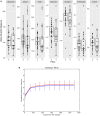Species-Level Salivary Microbial Indicators of Well-Resolved Periodontitis: A Preliminary Investigation
- PMID: 31681625
- PMCID: PMC6797555
- DOI: 10.3389/fcimb.2019.00347
Species-Level Salivary Microbial Indicators of Well-Resolved Periodontitis: A Preliminary Investigation
Abstract
Objective: To profile the salivary microbiomes of a Hong Kong Chinese cohort at a species-level resolution and determine species that discriminated clinically resolved periodontitis from periodontally healthy cases. Methods: Salivary microbiomes of 35 Hong Kong Chinese subjects' under routine supportive dental care were analyzed. All subjects had been treated for any dental caries or periodontal disease with all restorative treatment completed at least 1 year ago and had ≤3 residual pockets. They were categorized based on a past diagnosis of chronic periodontitis into "healthy" (H) or "periodontitis" (P) categories. Unstimulated whole saliva was collected, genomic DNA was isolated, and high throughput Illumina MiSeq sequencing of 16S rRNA (V3-V4) gene amplicons was performed. The sequences were assigned taxonomy at the species level by using a BLASTN based algorithm that used a combined reference database of HOMD RefSeqV14.51, HOMD RefSeqExtended V1.1 and GreenGeneGold. Species-level OTUs were subjected to downstream analysis in QIIME and R. For P and H group comparisons, community diversity measures were compared, differentially abundant species were determined using DESeq2, and disease indicator species were determined using multi-level pattern analysis within the R package "indicspecies." Results: P subjects were significantly older than H subjects (p = 0.003) but not significantly different in their BOP scores (p = 0.82). No significant differences were noted in alpha diversity measures after adjusting for age, gender, and BOP or in the beta diversity estimates. Four species; Treponema sp. oral taxon 237, TM7 sp. Oral Taxon A56, Prevotella sp. oral taxon 314, Prevotella sp. oral taxon 304, and Capnocytophaga leadbetteri were significantly more abundant in P than in the H group. Indicator species analysis showed 7 significant indicators species of P group. Fusobacterium sp oral taxon 370 was the sole positive indicator of P group (positive predictive value = 0.9, p = 0.04). Significant indicators of the H category were Leptotrichia buccalis, Corynebacterium matruchotii, Leptotrichia hofstadii, and Streptococcus intermedius. Conclusion: This exploratory study showed salivary microbial species could discriminate treated, well-maintained chronic periodontitis from healthy controls with similar gingival inflammation levels. The findings suggest that certain salivary microbiome features may identify periodontitis-susceptible individuals despite clinical disease resolution.
Keywords: 16S rRNA gene sequencing; oral microbiome; periodontal diseases; saliva; salivary microbiota.
Copyright © 2019 Acharya, Chen, Chan, Watt, Jin and Mattheos.
Figures





Similar articles
-
Salivary Microbiome Diversity in Caries-Free and Caries-Affected Children.Int J Mol Sci. 2016 Nov 25;17(12):1978. doi: 10.3390/ijms17121978. Int J Mol Sci. 2016. PMID: 27898021 Free PMC article.
-
The salivary microbiome as a diagnostic biomarker of periodontitis: a 16S multi-batch study before and after the removal of batch effects.Front Cell Infect Microbiol. 2024 Jul 12;14:1405699. doi: 10.3389/fcimb.2024.1405699. eCollection 2024. Front Cell Infect Microbiol. 2024. PMID: 39071165 Free PMC article.
-
Identification of Salivary Microbiota and Its Association With Host Inflammatory Mediators in Periodontitis.Front Cell Infect Microbiol. 2019 Jun 21;9:216. doi: 10.3389/fcimb.2019.00216. eCollection 2019. Front Cell Infect Microbiol. 2019. PMID: 31281801 Free PMC article.
-
Profiling of Oral Bacterial Communities.J Dent Res. 2020 Jun;99(6):621-629. doi: 10.1177/0022034520914594. Epub 2020 Apr 14. J Dent Res. 2020. PMID: 32286907 Free PMC article. Review.
-
Comparative analysis of bacterial abundance and diversity in tumour tissue of oral squamous cell carcinoma and non-tumour tissue: insights from a systematic review of 16S ribosomal RNA sequencing.BMC Oral Health. 2025 Apr 16;25(1):577. doi: 10.1186/s12903-025-05941-3. BMC Oral Health. 2025. PMID: 40241078 Free PMC article.
Cited by
-
Salivary Microbial Dysbiosis Is Associated With Peri-Implantitis: A Case-Control Study in a Brazilian Population.Front Cell Infect Microbiol. 2022 Jan 5;11:696432. doi: 10.3389/fcimb.2021.696432. eCollection 2021. Front Cell Infect Microbiol. 2022. PMID: 35071026 Free PMC article.
-
Saliva assay: a call for methodological standardization.J Periodontal Implant Sci. 2025 Feb;55(1):2-17. doi: 10.5051/jpis.2304180209. Epub 2024 Jun 18. J Periodontal Implant Sci. 2025. PMID: 39058348 Free PMC article. Review.
-
Polymicrobial periodontal disease triggers a wide radius of effect and unique virome.NPJ Biofilms Microbiomes. 2020 Mar 10;6(1):10. doi: 10.1038/s41522-020-0120-7. NPJ Biofilms Microbiomes. 2020. PMID: 32157085 Free PMC article.
-
Corynebacterium matruchotii Demography and Adhesion Determinants in the Oral Cavity of Healthy Individuals.Microorganisms. 2020 Nov 13;8(11):1780. doi: 10.3390/microorganisms8111780. Microorganisms. 2020. PMID: 33202844 Free PMC article.
-
Bacteria of healthy periodontal tissues as candidates of probiotics: a systematic review.Eur J Med Res. 2024 Jun 14;29(1):328. doi: 10.1186/s40001-024-01908-2. Eur J Med Res. 2024. PMID: 38877601 Free PMC article.
References
Publication types
MeSH terms
Substances
LinkOut - more resources
Full Text Sources
Miscellaneous

